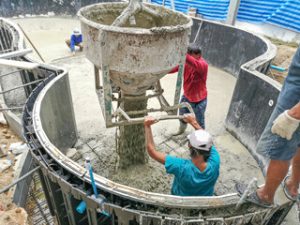Mold Remediation Provo involves a thorough inspection to assess the extent of contamination. It includes addressing the cause of the problem so it does not return.

Preventive measures include controlling humidity and using a cleaning solution like white distilled vinegar or baking soda to clean surfaces. If the problem persists, call a remediation specialist.
Mold spores thrive in locations and on materials where moisture and oxygen are present. If the conditions are right, they can grow and destroy whatever they touch. For this reason, regular inspection and testing for mold is important. This allows building owners to identify and address potential issues before they cause significant structural damage or health problems for occupants.
If a building owner is experiencing signs of a mold infestation, they should hire a professional to perform a mold remediation. During this process, the affected area will be isolated and sealed off to prevent the spread of mold spores throughout the rest of the property. Those involved in the clean-up should be trained in handling hazardous materials and should use appropriate protective equipment and cleaning procedures to minimize exposure to mold spores.
For example, those performing a mold remediation should wear an NIOSH-rated respirator with HEPA filter cartridges to protect against harmful contaminants. They should also wear disposable protective clothing to prevent the transfer of spores from their skin to other surfaces. Finally, they should set up a decontamination room where they can clean their equipment and themselves before and after leaving the contaminated area.
Preventive measures can also help protect the integrity of a building’s envelope. The building envelope includes the walls, windows, doors, and roof that separate the interior of a structure from outside elements such as weather, water, and air infiltration. Regularly inspecting and sealing any cracks or gaps in the building envelope will help protect it against mold growth.
In addition to preventing the spread of mold spores, preventive measures can also help preserve collections and artifacts. When mold grows in collections, it can attack books, documents, art on paper, and other paper-based items by digesting them, which can weaken them and cause permanent damage. Furthermore, molds often contain colored substances that stain the materials they colonize. This can make the affected items look discolored and can lead to further damage when the weakened organic material absorbs more water.
Cleaning
The cleaning phase of mold remediation is a crucial part of the process. Any infested materials are removed, wrapped in plastic bags to prevent contamination and disposed of according to local environmental regulations. Non-porous surfaces can be scrubbed with detergents, while more extensive contamination may require antimicrobial treatments to kill spores and prevent regrowth. Moisture control is also important, using fans and dehumidifiers to reduce humidity levels to a safe range. In confined spaces like crawlspaces and pipe chases, oxygen testing is often used to monitor air quality.
The moldy odor caused by mold growth is often the most difficult to remove. This smell is due to the microbial volatile organic compounds (MVOCs) produced by molds during growth. A specialized industrial-strength ozone generator can be used to destroy MVOCs and eliminate the odor.
Mold spores are everywhere in the indoor environment. Removing a visible mold infestation is only the first step in a successful remediation project. A mold remediation professional will identify the source of the problem and remove or correct it to prevent future problems.
For example, if the mold is a result of an ongoing leak in a basement, it may be necessary to replace the flooring and wall materials. Mold can be a significant health risk for people with allergies, asthma or compromised immune systems, and long-term exposure can lead to more serious health issues. Remediation is the only way to ensure that the mold does not return and that a healthy indoor environment is maintained for the building’s occupants.
In some cases, a full remediation of a mold problem will involve the removal of non-porous materials such as drywall, insulation and carpeting. This can be a very time-consuming and labor intensive part of the process. However, this is required to fully address the root cause of the problem and ensure that the mold does not recur.
In addition to the removal of non-porous materials, a thorough cleaning of all surfaces and components is required during a remediation project. This can include the use of water and commercial cleaning products, many of which are formulated specifically for the removal of mold. Some of these cleaners are based on everyday homeowner liquids such as Hydrogen Peroxide, others are biocides or fungicides that kill fungal-based organisms and some are specially designed to penetrate porous surfaces and help loosen hyphae in order to remove them.
Dehumidification
If your home or business has been affected by a water damage disaster, it is important to have all moisture problems resolved. Moisture leads to mold, rot and other structural issues that can lead to major and costly repairs. Dehumidification is a key step in this process, and it helps reduce the spread of mold, musty odors and other health issues that are associated with excess moisture.
Mold spores thrive in moist environments and typically form when the humidity is over 60%. The spores then settle and grow into a mold colony, which can cause musty odors, drywall and wood rot, and can even lead to respiratory problems for people with allergies or breathing difficulties. In addition, the mold spores can be airborne and travel throughout your building. In many cases, excess moisture also contributes to the development of biological contaminants such as bacteria and yeasts that can affect the indoor environment.
Dehumidification is an important part of the mold remediation process because it helps to lower the humidity and accelerates the drying of the affected materials. This is particularly important in areas with significant water damage, such as basements, attics, and behind walls. If these areas are not thoroughly dried, the moisture can penetrate deep into the structure and create concealed areas of dampness that can eventually lead to mold growth, rot and other structural damage.
During the cleaning phase of the mold remediation process, non-structural materials that are impacted by mold and/or water damage are removed and discarded. This typically includes drywall, carpeting, insulation and other non-porous materials. Nonporous materials that are salvageable, such as tile, may be treated with fungicides to prevent future growth of the fungus.
The fungicide treatments used in this stage are typically not fungicidal, meaning that they do not kill the existing mold or prevent it from growing again. This is because fungicides do not penetrate deeply into the surface of the material to destroy the embedded hyphae. Because of this, a second threshold is often used, which minimizes the risks to human health by reducing the number of spores present on the surface.
Containment
Mold remediation is a specialized process that not only removes the visible signs of mold growth but also fixes the conditions that caused it to grow in the first place. A thorough remediation plan will include controlling humidity levels, addressing leaks promptly and ensuring proper ventilation to prevent further mold growth after the problem is addressed. It should also include preventive measures to inhibit future mold growth such as regular inspections.
Before proceeding with the remediation process, it is essential to set up containment and make sure that any contaminated items are properly sealed and bagged before disposal. This will protect workers from inhaling the mold spores and will ensure that they do not spread to other areas of the building. A decontamination room should be set up for workers to enter and exit the contaminated area, which should be separated from other areas of the building by an airlock or double layers of plastic sheeting. This decontamination room should be HEPA vacuumed to eliminate any lingering mold spores.
It is also recommended that any contaminated materials be bagged and disposed of in an impermeable trash container to protect workers from contact with potentially toxic chemicals and gases in the crawl spaces or pipe chases of older buildings. This is especially important in healthcare facilities and homes with individuals with respiratory illnesses or compromised immune systems.
Once the contaminated materials are removed from the site, the walls and floors can be cleaned and deodorized. Non-porous materials such as drywall and carpeting can usually be cleaned, but porous materials such as wood framing may need to be removed and discarded. This is another example of why it is advisable to work with an experienced professional, as they have the necessary equipment to safely and thoroughly remove and dispose of these materials.
Finally, any non-porous surfaces that have been impacted by mold can be treated with antimicrobial agents to kill any residual mold spores and inhibit future growth. These products are typically available in a wide range of forms including foam, powder, liquid and aerosol, which can be applied directly to the surface or as a spray. When used correctly, these products can be very effective in eliminating existing mold and preventing future outbreaks.








